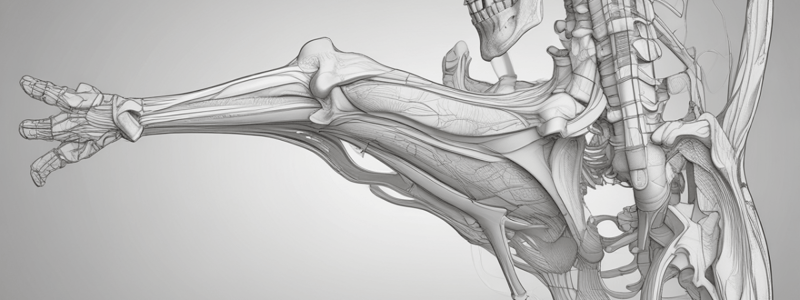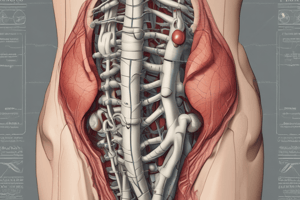Podcast
Questions and Answers
What type of tilt occurs when the acetabulum moves on the femur with hip flexion?
What type of tilt occurs when the acetabulum moves on the femur with hip flexion?
- Retroversion
- Lateral tilt
- Anterior tilt (correct)
- Posterior tilt
Which movement occurs when the pelvis rotates around the anterior-posterior axis?
Which movement occurs when the pelvis rotates around the anterior-posterior axis?
- Anterior-posterior tilt (correct)
- External-internal rotations
- Abduction-adduction
- Lateral tilts
What occurs in the sacrum during anteversion of the pelvis?
What occurs in the sacrum during anteversion of the pelvis?
- Rotation
- Lateral tilt
- Nutation
- Counternutation (correct)
What type of movement occurs in the transverse plane during rotational movement of the pelvis?
What type of movement occurs in the transverse plane during rotational movement of the pelvis?
Which axis is associated with lateral tilt of the pelvis?
Which axis is associated with lateral tilt of the pelvis?
What occurs in the lumbar spine during rotational movement of the pelvis?
What occurs in the lumbar spine during rotational movement of the pelvis?
What is associated with descending ASIS and ascending PSIS?
What is associated with descending ASIS and ascending PSIS?
During gait, what occurs in the pelvis?
During gait, what occurs in the pelvis?
What is the primary purpose of the lumber multifidi muscle during load changes?
What is the primary purpose of the lumber multifidi muscle during load changes?
During a closed kinetic chain, what is the primary movement of the femur in the hip joint?
During a closed kinetic chain, what is the primary movement of the femur in the hip joint?
Which of the following muscles does NOT help to stabilize the SIJ?
Which of the following muscles does NOT help to stabilize the SIJ?
What is the term for the combined movements of the hip, pelvis, and lumbar spine to increase overall motion?
What is the term for the combined movements of the hip, pelvis, and lumbar spine to increase overall motion?
In which position is the SIJ in its close-packed position?
In which position is the SIJ in its close-packed position?
What is the term for the movements of the pelvis?
What is the term for the movements of the pelvis?
Which of the following is NOT a primary movement of the pelvis?
Which of the following is NOT a primary movement of the pelvis?
What is the term for the study of the movement of bones?
What is the term for the study of the movement of bones?
What is the primary function of the anterior sacroiliac ligament?
What is the primary function of the anterior sacroiliac ligament?
What is the main kinematic movement of the SI joint?
What is the main kinematic movement of the SI joint?
What is the definition of nutation?
What is the definition of nutation?
Which of the following ligaments is considered a secondary stabilizer of the SI joint?
Which of the following ligaments is considered a secondary stabilizer of the SI joint?
What is the main functional consideration of nutation and counternutation?
What is the main functional consideration of nutation and counternutation?
What is the opposite movement of nutation?
What is the opposite movement of nutation?
What is the plane of movement for nutation and counternutation?
What is the plane of movement for nutation and counternutation?
What is the approximate degree of rotation in the SI joint?
What is the approximate degree of rotation in the SI joint?
What type of joint is the sacrococcygeal joint?
What type of joint is the sacrococcygeal joint?
What is the primary function of the pelvis in terms of weight transmission?
What is the primary function of the pelvis in terms of weight transmission?
What is the term for the union of the ilium, pubis, and ischium bones?
What is the term for the union of the ilium, pubis, and ischium bones?
What is the name of the joint that connects the right and left innominates anteriorly?
What is the name of the joint that connects the right and left innominates anteriorly?
What is the degree of freedom of the sacrococcygeal joint?
What is the degree of freedom of the sacrococcygeal joint?
What is the function of the pelvis in terms of supporting organs?
What is the function of the pelvis in terms of supporting organs?
What is the name of the joint that connects the sacrum and the coccyx?
What is the name of the joint that connects the sacrum and the coccyx?
What is the term for the osteoligamentous ring formed by the connections of the right and left innominates?
What is the term for the osteoligamentous ring formed by the connections of the right and left innominates?
Which muscles are responsible for anteversion of the pelvis?
Which muscles are responsible for anteversion of the pelvis?
What is the main reason why lying supine is potentially the most difficult position for the baby to go through the pelvic outlet during childbirth?
What is the main reason why lying supine is potentially the most difficult position for the baby to go through the pelvic outlet during childbirth?
Which muscles are responsible for lumbar extension and lumbar posterior chain?
Which muscles are responsible for lumbar extension and lumbar posterior chain?
What type of interactions are responsible for movements in the 3 planes of the pelvis?
What type of interactions are responsible for movements in the 3 planes of the pelvis?
Which muscles are responsible for retroversion of the pelvis?
Which muscles are responsible for retroversion of the pelvis?
What is the term for the movement of the pelvis during the gait cycle?
What is the term for the movement of the pelvis during the gait cycle?
What is the main function of the muscles that stabilize the SI joint?
What is the main function of the muscles that stabilize the SI joint?
Which of the following muscles are not responsible for stabilizing the SI joint?
Which of the following muscles are not responsible for stabilizing the SI joint?
Flashcards
Anterior-posterior pelvic tilt (APT)
Anterior-posterior pelvic tilt (APT)
Hip flexion; posterior pelvic tilt (PPT): hip extension
Pelvic Abduction-Adduction
Pelvic Abduction-Adduction
"Hip hike"
Pelvic External-Internal Rotation
Pelvic External-Internal Rotation
Right pelvic rotation (Right leg internal rotation, Left leg external rotation)
Pelvic Anteversion
Pelvic Anteversion
Signup and view all the flashcards
Pelvic Retroversion
Pelvic Retroversion
Signup and view all the flashcards
Lateral Pelvic Tilt
Lateral Pelvic Tilt
Signup and view all the flashcards
Pelvic Rotation
Pelvic Rotation
Signup and view all the flashcards
Pelvic Stability under Load
Pelvic Stability under Load
Signup and view all the flashcards
Pelvic Retroversion and Stability
Pelvic Retroversion and Stability
Signup and view all the flashcards
SIJ Stabilizing Muscles
SIJ Stabilizing Muscles
Signup and view all the flashcards
Lumbopelvic Rhythm
Lumbopelvic Rhythm
Signup and view all the flashcards
Hip osteokinematics (WB)
Hip osteokinematics (WB)
Signup and view all the flashcards
Innominate Bones
Innominate Bones
Signup and view all the flashcards
Pelvic Functions
Pelvic Functions
Signup and view all the flashcards
Sacrococcygeal Joint
Sacrococcygeal Joint
Signup and view all the flashcards
Pubic Symphysis
Pubic Symphysis
Signup and view all the flashcards
Sacroiliac Joint (SIJ)
Sacroiliac Joint (SIJ)
Signup and view all the flashcards
Lumbosacral Joint
Lumbosacral Joint
Signup and view all the flashcards
Acetabulofemoral Joint
Acetabulofemoral Joint
Signup and view all the flashcards
Pelvic Stabilizing Muscles
Pelvic Stabilizing Muscles
Signup and view all the flashcards
Pelvic Stabilizers
Pelvic Stabilizers
Signup and view all the flashcards
Pelvic Osteology
Pelvic Osteology
Signup and view all the flashcards
Pelvis Functional Anatomy
Pelvis Functional Anatomy
Signup and view all the flashcards
Study Notes
Pelvic Movements
- Anterior-posterior pelvic tilt (APT): hip flexion; posterior pelvic tilt (PPT): hip extension
- Abduction-adduction: "hip hike"
- External-internal rotations: right pelvic rotation (R leg IR, L leg ER)
Arthrokinematics of the Pelvis
- Anteversion: anterior tilt, lateral axis (lumbosacral and coxal-femur), descent of ASIS, ascent of PSIS, sacrum counternutation, associated with lumbar hypelordosis and lumbar extension movement
- Retroversion: posterior tilt, lateral axis (lumbosacral and coxal-femur), ascent of ASIS, descent of PSIS, sacrum nutation, associated with lumbar kyphosis and lumbar flexion movement
Osteokinematics of the Pelvis
- Lateral tilt: lateral movement, frontal plane, AP axis (between lumbosacral and coxal-femoral), descent of ASIS from one side, ascent of contralateral ASIS, associated with movements of abduction and adduction
- Rotation: rotational movement, transverse plane, superior-inferior axis, anterior movement of ASIS of one side, posterior movement of contralateral ASIS, associated with movements during gait
Stability during Load Changes
- When we walk, run, or give birth, there is high mechanical stress on the pelvis, and the pelvis generates movements to release joint stress
- Pelvis in retroversion: more congruence, sacrum in nutation, stability during load changes
- Muscles that reinforce and stabilize the SIJ: erector spinae, lumbar multifidi, abdominal muscles, hip extensor muscles, latissimus dorsi, iliacus, and piriformis
Lumbopelvic Rhythm
- Combined and coordinated movements of hip, pelvis, and lumbar spine to increase overall motion
- Osteokinematics of the hip: closed kinetic chain (WB), pelvic biomechanics
Osteology of the Pelvis
- Each innominate is the union of three bones: ilium, pubis, and ischium
- The pelvis is a complete osteoligamentous ring, formed by the connections of the right and left innominates
- Functions of the pelvis: attachment point for muscles, transmits weight of the upper body, and supports organs involved in bowel, bladder, and reproductive functions
Functional Anatomy of the Pelvis
- Intrinsic joints of the pelvis: sacrococcygeal joint, pubic symphysis, and sacroiliac joint
- Extrinsic joints of the pelvis: lumbosacral joint and acetabulofemoral joint
Kinetics and Stabilizers
- Muscles that act in pelvic movements: ilopsoas, rectus femoris, sartorius, erector spinae, trunk extensors, gluteus maximus, hamstrings, piriformis, rectus abdominis, and external oblique
- Stabilizers of the pelvis: ligaments, muscles, and connective tissues
Studying That Suits You
Use AI to generate personalized quizzes and flashcards to suit your learning preferences.




